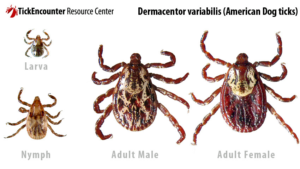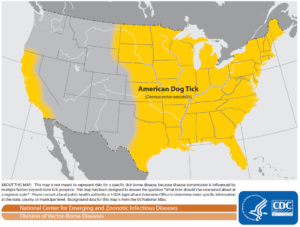This tick is widely found east of the Rocky Mountains and is most common in areas with little to no tree cover, such as grassy fields or along trails. They feed on a variety of hosts, including pets and humans. While both male and female adults feed, male American dog ticks do not become engorged with blood. This species of tick is hardy and can survive up to two years without a host. Larvae are active April through September, nymphs May through July and adults April though early August.

American Dog Ticks are colorful and larger than other species, growing up to 1.5 centimeters when fully engorged. Females are recognizable by the large off white area on the back, shaped like a shield, on a dark brown body. This kind of tick does not transmit Lyme disease but is capable of transmitting other tick-borne disease, such as Rocky Mountain Spotted Fever.
Of the many different tick species found throughout the world, only a select few bite and transmit disease to humans. These maps provide general insight into the expected distribution these human-biting ticks in the contiguous United States. Populations of ticks may be found outside noted areas. Naturally occurring populations of the ticks described below do not occur in Alaska; however, the brown dog tick is endemic in Hawaii.
Note that adult ticks are the easiest to identify and male and female ticks of the same species may look different. Nymphal and larval ticks are very small and may be difficult to identify.

